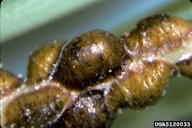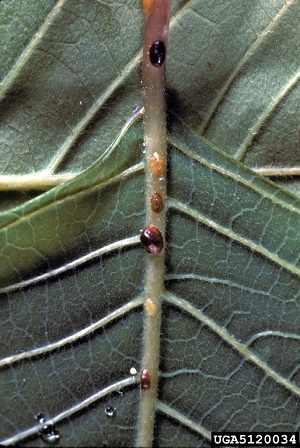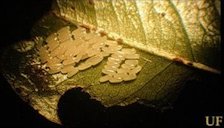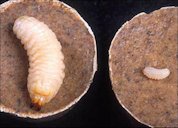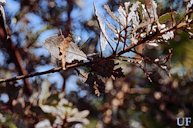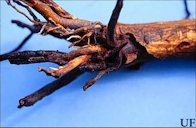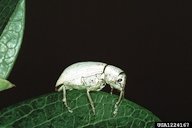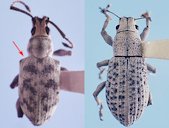| Lychee and Longan Pests | ||||||||||||||||||||||||
|---|---|---|---|---|---|---|---|---|---|---|---|---|---|---|---|---|---|---|---|---|---|---|---|---|
| Back
To Lychee Page Longan Page  Fig. 1 Scanning electron micrograph of the Lychee Erinose Mite (LEM), Aceria litchii Fig. 2 LEM infests immature Lychee leaves and forms small blisters Fig. 3 The erineum is a reddish-brown hairy mass that, in some instances, can cover the entire underside of the leaf, which may become distorted or curled.  Fig. 5 Soft scale, Philephedra tuberculosa 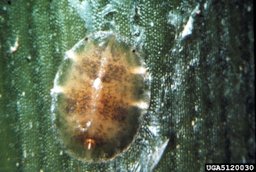 Fig. 6 Fig. 6Hemispherical scale, Saissetia coffeae (Walker) 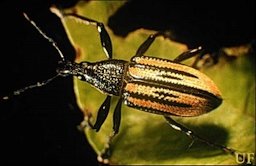 Fig. 9 Adult diaprepes root weevil, Diaprepes abbreviatus (Linnaeus) 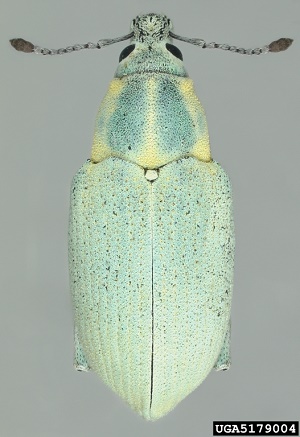 Fig. 14 Citrus root weevil, Pachnaeus litus (Germar, 1824) 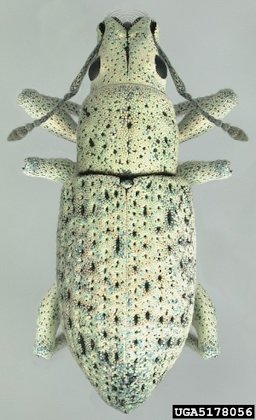 Fig. 17 Little leaf notcher, Artipus floridanus, adult 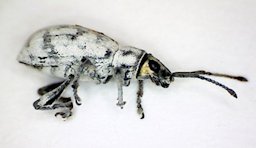 Fig. 19  Adult Sri Lankan weevil, Myllocerus undecimpustulatus undatus Marshall, with yellowish coloration of head
| The
panicles (thyrses) and flowers
of lychee are attacked by a number of moth pests. Periodically, plumose
(Morganela longispina)
and Philephedra
tuberculosa scales attack stems, and heavy infestations
may cause stem dieback. Adult Diaprepes root weevils (Diaprepes abbreviatus)
and citrus root weevils (Pachnaeus
litus)
feed on lychee leaves, and their larvae feed on the roots of lychee
trees causing a loss of tree vigor. Several nematode species (reniform,
Rotylenchulus reniformis;
and sheath nematode, Hemicriconemoides
mangiferae) cause decline of young lychee trees. 4 As documented in an article by the USDA Agriculture Research Service the fruit is not susceptible to the Caribbean Fruit fly: Florida Growers Like Lychees and Longans Lychee Erinose Mite (LEM) (does not apply to the longan) Aceria litchii The Lychee Erinose Mite (LEM), Aceria litchii (Fig. 1), was found in a 3-acre commercial lychee orchard in Lee County on Pine Island, FL in February 2018. Originally showing up in Cape Coral and Pine Island last year, the lychee erinose mite is now in Charlotte County as well as Collier County. In fact a quarantine prevents lychee fruit or plant parts from moving out of Lee County to other locations in Florida. 8 LEM is highly host-specific and is mostly known to attack lychee; however, it was also reported infesting longans (Dimocarpus longan) in Taiwan. Young Lychee trees are more susceptible to LEM infestations because of their frequent shoot and leaf flushing. No information is available about the damage and susceptibility of longan cultivars. 7 The mite feeding activity causes small blisters on the top side of the leaf (Fig. 2). This is followed by distinct reddish-brown, hairy, felt-like growths on the underside of leaves (Fig. 3). Loss of fruit production can reach eighty-percent for infested trees. 8 This pest can be transferred by air currents or honey bees. Moreover, LEM can be disseminated by the movement of infested plants, especially when plants are propagated as air layers from infested parent trees. The mite can also be disseminated by humans touching the symptomatic leaves. 7 If you spot lychee trees with symptoms of the erinose mite infestation, please notify FDACS – DPI at 1-888-397-1517, DPIHelpline@FreshFromFlorida.com or to the UF/IFAS Commercial Tropical Fruit Extension Agent (Jeff Wasielewski, sflhort@ufl.edu, 305-248-3311, ext. 227).
Fig. 4. Map of affected counties Further Reading PEST ALERT, Florida Department of Agriculture and Consumer Services pdf Management Recommendations for the Lychee Erinose Mite (LEM), University of Florida, IFAS/TREC pdf Commercial Grower Control Recommendations for the Lychee Erinose Mite (LEM), University of Florida, Miami-Dade County pdf Research update on the Lychee Erinose Mite (Aceria litchii), University of Florida, IFAS/TREC pdf Lychee Erinose Mite (LEM) Frequently Asked Questions, University of Florida, IFAS/TREC pdf (Archived) Lychee tree recovery post severe pruning, University of Florida, IFAS/TREC pdf Scales Andaspis punicae, Thysanofiorinia nephelii, Morganella longispina, Coccus acutissimus, Coccus longulus, Saissetia coffeae, Ceroplastes cirripediformis, Philephedra tuberculosa Scales are plant-feeding insects that are often managed by natural and released parasites, predators, and pathogens. In places where the natural balance of predation has been disrupted, scale populations may increase to levels requiring treatment. Most effective control is obtained when the scales are in nymphal stages, as egg and adult stages are recalcitrant to insecticide applications. 1 Symptoms of scale infestation include leaf chlorosis, leaf abscission, dieback of stems and limbs, and sooty mold on the surfaces of leaves and stems. 1 Philephedra scale (Fig. 5) Philephedra tuberculosa P. tuberculosa scales attack stems, and heavy infestations may cause stem dieback. 4 Hemispherical scale (Fig. 6) Saissetia coffeae (Walker)
Further Reading Philephedra Scale on Glaucous Cassia, University of Florida, Lee County pdf A guide to Scale Insect Identification, University of Florida pdf Citrus Root Weevils Diaprepes abbreviatus, Pachnaeus litus, Artipus floridanus The larvae of these root weevil species impact tree health through direct root damage, which also provides entry routes for fungal infection in the root tissue. D. abbreviatus larvae are by far the largest and most damaging of these weevils. Mature weevils cause only minimal damage from leaf feeding, which is apparent as notches on leaf margins. Most mature female root weevils place their eggs in clusters between two leaves on newly flushed foliage. After 10 - 20 days, eggs hatch, and larvae fall to the ground. The larvae begin feeding on the fibrous feeder roots. 1 With the exception of little leaf notchers that prefer a weed host, larval feeding injury to the roots by other root weevils, particularly Diaprepes root weevil, can have a devastating effect on citrus trees, since all larval stages feed on the roots for most of the year. 1 Further Reading Florida Citrus Production Guide: Citrus Root Weevils, University of Florida pdf Diaprepes root weevil (Fig. 9) Diaprepes abbreviatus Female root weevils generally oviposit eggs in clusters between two leaves on newly flushed foliage. After ten or twenty days, eggs hatch and larvae fall to the ground. The larvae begin feeding on the fibrous feeder roots. Successively larger larval instars feed on larger roots. The final larval stages (of at least eleven) proceed to the tap root and major lateral roots of the tree. 2
Fig. 10. Egg mass of D. abbreviatus (L.), on citrus leaf. Fig. 11. Young (right) and older (left) larvae of the diaprepes root weevil Fig. 12. Damage, notching on leaves Fig. 13. Damage to citrus tree roots Further Reading Diaprepes root weevil, Diaprepes abbreviatus, University of Florida pdf Diaprepes Root Weevil, University of California pdf Citrus root weevil (Fig.14) Pachnaeus litus (Germar, 1824)
Little leaf notcher (Fig.17) Artipus floridanus Little leaf notcher has three generations per year. Although there is some overlap of generations, adults appear most abundant in a tree in April/May, July/August, and October/November. All adult weevils are attracted to the nonreflective silhouette of the citrus tree trunk. Little leaf notcher is flightless and must crawl up the trunk, while other species will fly to the canopy. 3
Adult Sri Lankan weevil (Fig.19) Myllocerus undecimpustulatus undatus When adult weevils feed on leaves, they feed inward from the leaf margins (or edges), causing the typical leaf notching. There are some instances where the leaf material is almost completely defoliated, where the weevil has fed along the leaf veins. The adults prefer new plant growth. Intense feeding by numerous weevils may cause plant decline or stunting. Young seedlings may not survive a large amount of feeding damage. With healthy plants, however, the feeding damage may be considered cosmetic if the plant recovers. 6
Fig. 20. Adult Sri Lankan weevil, M. undecimpustulatus undatus Marshall (left) comparison with the little leaf notcher, Artipus floridanus Horn (right). Further Reading Sri Lankan weevil Myllocerus undecimpustulatus undatus Marshall, University of Florida pdf Lychee webworm Crocidosema sp. This moth is a recently discovered lepidopteran species and apparently an introduced species to Florida from the Caribbean. Reports from extension research in South Florida state that this moth is most active between six and nine in the evening, and oviposition occurs on newly emerging vegetative and reproductive buds. The life cycle of the moth is about 35 days, depending on temperature. Populations begin to build during November and peak during January and February. No alternative host plants have been found, and it is hypothesized that the moth maintains a very low population in lychee and longan groves from April through October. 1 The current recommendation is to scout during November through February for signs of wilted or dead terminal shoots, webbing, and very small fruit bore holes. If 30 percent of the terminal shoots inspected show signs of the moth, insecticide applications are advised. 1 Corky Bark Marmara sp. Branches infested with this barkminer become covered with rough, brownish lesions, which range in size from 6 - 18 millimeters. The larval stage of the moth irritates the outer bark of stems, branches, and the trunk. This irritation results in cork-like lesions. However, no apparent economic damage from this larvae has been observed, and control is not recommended. 1 Further Reading A Guide to Soil Insect Pest Identification, University of Florida pdf | |||||||||||||||||||||||
| Bibliography 1 Mossler, Mark. "Florida Crop/Pest Management Profile: Lychee and Longan." Horticultural Sciences Dept., UF/IFAS Extension, CIR1400, Pub. Mar. 2002, Revised June 2009, Reviewed June 2012, AskIFAS, Archived, edis.ifas.ufl.edu. Accessed 23 Mar. 2015. 2 Weissling, T. J., et al. "Diaprepes Root Weevil, Diaprepes abbreviatus (Linnaeus) (Insecta: Coleoptera: Curculionidae)." Entomology and Nematology Dept., UF/IFAS Extension, EENY-024, Published Feb. 1998, Revised Nov. 2012, and June 2022, AskIFAS, edis.ifas.ufl.edu/in151. Accessed 12 Sept. 2016, 2 July 2019, 4 Jan. 2024. 3 Duncan, Larry W., and Catharine Mannion. "2020-2021 Florida Citrus Pest Management Guide: Citrus Root Weevils." Entomology and Nematology Dept., UF/ IFAS Extension, ENY-611, Original pub. July 2000, Most recent Pub. May 2023, AskIFAS, edis.ifas.ufl.edu/cg006. Accessed 12 Sept. 2016, 9 May 2020, 14 June 2021, 2 Jan. 2023. 4 Crane, Jonathan H., et al. "Lychee Growing in the Florida Home Landscape." Horticultural Sciences Dept., UF/IFAS Extension, HS-6, Original pub. Oct. 1968, Revised Feb. 1998, Feb. 2005, Oct. 2008, Oct. 2013 and Nov. 2016, Reviewed Dec. 2019, AskIFAS, edis.ifas.ufl.edu/mg051. Accessed 21 Feb. 2017, 9 May 2020. 5 Jonathan H. Crane, et al. "Longan Growing in the Florida Landscape." Horticultural Sciences Dept., UF/IFAS Extension, HS-49, Original pub. Nov. 1978, Revised Apr. 1994, Nov. 2000, Sept. 2005, Oct. 2008, and Nov. 2016, Reviewed Dec. 2019, AskIFAS, edis.ifas.ufl.edu/mg049. Accessed 8 Jan. 2017, 9 May 2020. 6 Neil, Anita. "Sri Lankan weevil Myllocerus undecimpustulatus undatus Marshall." Entomology and Nematology Dept., UF/ IFAS Extension, EENY579, Original pub. Nov. 2013, Rev. July 2020, AskIFAS, edis.ifas.ufl.edu/in1016. Accessed 3 Mar. 2017, 1 Feb. 2019, 14 June 2021. 7 Carrillo, Daniel, et al. "New Serious Pest of Lychee and Longan Trees Found in Florida." Entomology and Nematology Dept., UF/IFAS Tropical Research and Education Center, UF/IFAS/TREC Blogs, blogs.ifas.ufl.edu/trec/2018/03/19/new-serious-pest-lychee-longan-trees-found-florida/. Accessed 2 July 2019. 8 Mitchell, Ralph E. "Tiny, but mighty, the lychee erinose mite." UF/IFAS Extension Charlotte County, 5 June 2019, UF/IFAS Blogs, blogs.ifas.ufl.edu/charlotteco/2019/06/05/tiny-but-mighty-the-lychee-erinose-mite/. Accessed 2 July 2019. Photographs Fig. 1 Bauchan, Gary, and Ronald Ochoa. "Scanning electron micrograph of the Lychee Erinose Mite (LEM)." USDA, ARS, Beltsville, MD, UF/IFAS/TREC Blogs, blogs.ifas.ufl.edu/trec/2018/03/19/new-serious-pest-lychee-longan-trees-found-florida/. Accessed 2 July 2019. Fig. 2 "LEM infests immature Lychee leaves and forms small blisters." University of Florida Tropical Research and Education Center, UF/IFAS/TREC Blogs, blogs.ifas.ufl.edu/trec/2018/03/19/new-serious-pest-lychee-longan-trees-found-florida/. Accessed 2 July 2019. Fig. 3 "The erineum is a reddish-brown hairy mass that, in some instances, can cover the entire underside of the leaf, which may become distorted or curled." University of Florida Tropical Research and Education Center, UF/IFAS/TREC Blogs, blogs.ifas.ufl.edu/trec/2018/03/19/new-serious-pest-lychee-longan-trees-found-florida/. Accessed 2 July 2019. Fig. 4 "Map of Affected Counties." Lychee Erinose Mite, Florida Department of Agriculture and Consumer Services, May 2021, FDACS, www.fdacs.gov/Agriculture-Industry/Pests-and-Diseases/Plant-Pests-and-Diseases/Lychee-Erinose-Mite Fig. 5 "Soft scale, Philephedra tuberculosa.Nakahara & Gill." United States National Collection of Scale Insects Photographs Archive, USDA Agricultural Research Service, 2006, Bugwood, (CC BY-NC 3.0 US), bugwood.org. Accessed 23 Mar. 2015. Fig. 6,7,8 "Hemispherical scale, Saissetia coffeae (Walker)" United States National Collection of Scale Insects Photographs Archive, USDA Agricultural Research Service, 2006, Bugwood, bugwood.org. Accessed 23 Mar. 2015. Fig. 9 Giblin-Davis, R. M. "Adult diaprepes root weevil, Diaprepes abbreviatus (Linnaeus)." entremdept.ufl.edu. Accessed 23 Mar. 2015. Fig. 10 Butler, Jerry F. "Egg mass of Diaprepes abbreviatus (L.), on citrus leaf." University of Florida, edis.ifas.ufl.edu. Accessed 23 Mar. 2015. Fig. 11 Grub, Peggy. "Young (right) and older (left) larvae of the diaprepes root weevil, Diaprepes abbreviatus (Linnaeus)." USDA, edis.ifas.ufl.edu. Accessed 23 Mar. 2015. Fig. 12 Pena, Jorge. "Damage - notching on leaves - by Diaprepes abbreviatus (L.)." University of Florida, edis.ifas.ufl.edu. Accessed 23 Mar. 2015. Fig. 13 Pena, Jorge. "Damage to citrus tree roots by Diaprepes abbreviatus (L.)." University of Florida, edis.ifas.ufl.edu. Accessed 23 Mar. 2015. Fig. 14,15 Wright, Nathasha. "Citrus root weevil, Pachnaeus litus (Germar, 1824)." Florida Department of Agriculture and Consumer Services, 2007, Bugwood, (CC BY-NC 3.0 US), bugwood.org. Accessed 23 Mar. 2015. Fig. 16 Payne, Jerry A. "Citrus root weevil, Pachnaeus litus (Germar, 1824)." USDA Agricultural Research Service, 2003, Bugwood, (CC BY-NC 3.0 US), bugwood.org. Accessed 23 Mar. 2015. Fig. 17,18 Wright, Nathasha. "Citrus root weevil, Artipus floridanus (Horn, 1876)." Florida Department of Agriculture and Consumer Services, 2007, Bugwood, (CC BY-NC 3.0 US), bugwood.org. Accessed 26 Mar. 2015. Fig. 19 Neal, Anita. "Adult Sri Lankan weevil, Myllocerus undecimpustulatus undatus Marshall, with yellowish coloration of head." UF/IFAS, edis.ifas.ufl.edu. Accessed 3 Mar. 2017. Fig. 20 Skelley, Paul. "Adult Sri Lankan weevil, Myllocerus undecimpustulatus undatus Marshall (left) comparison with the little leaf notcher, Artipus floridanus Horn (right)." FDACS-Division of Plant Industry, UF/IFAS, edis.ifas.ufl.edu. Accessed 3 Mar. 2017. Published 23 Mar. 2015 LR. Last update 2 Jan. 2024 LR | ||||||||||||||||||||||||

